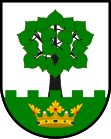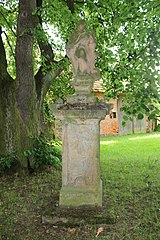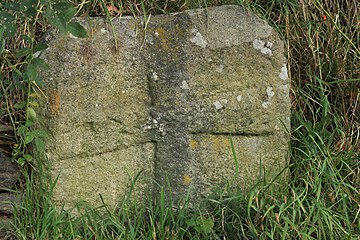Běleč na Křivoklátsku
| Běleč | ||||
|---|---|---|---|---|
|
||||
| Basic data | ||||
| State : |
|
|||
| Region : | Středočeský kraj | |||
| District : | Kladno | |||
| Area : | 1848.4855 ha | |||
| Geographic location : | 50 ° 3 ' N , 14 ° 0' E | |||
| Height: | 426 m nm | |||
| Residents : | 326 (Jan 1, 2019) | |||
| Postal code : | 273 63 | |||
| License plate : | S. | |||
| traffic | ||||
| Street: | Unhošť - Zbečno | |||
| structure | ||||
| Status: | local community | |||
| Districts: | 1 | |||
| administration | ||||
| Mayor : | Jiří Rohla (as of 2017) | |||
| Address: | Dukelská 64 273 63 Bratronice |
|||
| Municipality number: | 535010 | |||
| Website : | www.belec.cz | |||
| Location of Běleč in the Kladno district | ||||

|
||||
Běleč (German Bieletsch , 1939-1945 Bleichen ) is a municipality in the Czech Republic . It is located eleven kilometers southwest of Unhošť and belongs to the Okres Kladno . The municipality is a member of the Bratronicko microregion.
geography
Běleč is located on the upper reaches of the creek Vůznice in Křivoklátská highlands and is located in a nature preserve Křivoklátsko . To the north rises the Žilinský vrch (463 m), in the east the Kouty (473 m), the Vysoký vrch ( Großberg , 486 m) and the Tuchonín (488 m), to the southeast the Plechovka (473 m), in the south the Míšek ( 438 m), to the southwest the Skalka (435 m), to the west the Holý kopec (438 m) and to the northwest the Krchůvek (472 m). The state road II / 201 runs through Běleč between Křivoklát and Unhošť .
Neighboring towns are Ploskov, Sarvas and Lhota in the north, Bratronice , Borek, Mostecký Mlyn, Roučmídův Mlýn and Horní Bezděkov in the Northeast, Pohodnice, Poteplí, Malé Kyšice and Podkozí the east, Kouty, Chyňava , Zelená Bouda, Krkavčí Hora and Hýskov in the southeast, Skalka, Žlubinec, Nižbor , Dřevíč and Žloukovice in the south, Luby, Podřeže, Sýkořice and Zbečno in the south-west, Kaly, Novina, Klíčava, Písky and Požáry in the west, and Fialka and Leontýna in the north-west.
history
The village arose on the hunting route from Prague to Pürglitz Castle . The first evidence of settlement dates back to the 10th century, in 1930 an urn grave field was found during excavation work between the church and the municipal office.
The first written mention of the village of Běleč, which belongs to the sovereign estates, comes from the 11th century. At that time the village consisted of a noble farm with two hooves of land and five hens. The surrounding forests up to the Klíčava valley belonged to Běleč . In the course of time, nobles and Prague citizens alternated as owners of the estate. The kings Georg von Podiebrad and Vladislav II Jagiello thanked Wilhelm d. J. von Riesenberg at Rabí Castle for his services as Chief Chamberlain of the Kingdom of Bohemia, and gave him the village of Běleč as an addition to the office of Chief Chamberlain. In 1474, Vladislav II Jagiello freed the settlers of Běleč for their voluntary participation in three armed expeditions to Lusatia and Silesia and Austria from all royal inclines for ever. The associated sole power of disposal over the forests belonging to the village was ignored by the Pürglitz officials, so that the residents of Běleč filed several complaints about presumptuous felling and deer hunting in their forests. After the Bohemian Landtag had already twice unsuccessfully discussed the annexation of Běleč to the rule of Pürglitz at the request of Rudolf II , it agreed to this in 1594. In return, Rudolf II had to cede the Dehnici farm .
The first village judge is known to be Jan Kota in 1598, who bought the court from his predecessor Wenzel for 135 shock. Běleč was burned down during the Thirty Years War, six of the eleven estates were in desolation. A report from 1655 shows that at that time the main source of income for the men from Běleč was logging on the Berounka and the Vltava . In 1658, Emperor Leopold I pledged the crown rule of Pürglitz to Johann Adolf von Schwarzenberg . In 1685 Leopold I sold the rule to Ernst Joseph Count von Waldstein . In 1704 he had the church of St. Nicholas repaired.
In 1731 Johann Joseph Graf von Waldstein bequeathed the rule to his daughter and universal heiress Maria Anna Fürstin zu Fürstenberg , who in 1756 united her in a will with the rule of Kruschowitz and the Gut Nischburg to form a family entailment of 400,000 guilders. Half of the inheritance went to her sons Joseph Wenzel zu Fürstenberg-Stühlingen and Karl Egon I zu Fürstenberg, the other half to her daughters Henriette Fürstin von Thurn und Taxis and Maria Theresia zu Fürstenberg. She appointed her second-born son Karl Egon I as Fideikommisserbeer , who also acquired the shares of his siblings through compensation. In 1783 a branch church was consecrated in Bratronice, previously the village was parish to Zbečno . After the death of Karl Egon I, his eldest son Philipp Fürst zu Fürstenberg († 1790) inherited the property in 1787, followed by his children Karl Gabriel zu Fürstenberg († 1799) and Leopoldine Princess of Hesse-Rothenburg-Rheinfels. In 1803, the female heirs renounced a family settlement in favor of the minor Karl Egon II zu Fürstenberg and the princely and landgrave houses of Fürstenberg; Joachim Egon Landgraf von Fürstenberg was appointed as administrator until he came of age in 1817.
In 1843 Bieletsch / Beleč consisted of 43 houses with 410 inhabitants. There was a branch church of St. Nikolaus, a Meierhof with a small castle, a potash boiler and a grain floor. The sheep farm and the forester's house Skalka, the Hegerhaus Schmidtsgrund ( Kaly ), the Hegerhaus ( Kouty ) and the Ginčow castle ruins were located. The parish was Bratronitz . Until the middle of the 19th century, Bieletsch remained subject to Fideikommiss Pürglitz .
After the abolition of patrimonial formed Běleč / Biel Adige 1850 a district of the municipality Bratronice in District Rakonitz and judicial district Křivoklát . After the death of Karl Egon II zu Fürstenberg in 1854, his second-born son Max Egon I inherited the Fideikommiss Pürglitz. At that time, the owners of the Běleč chateau were the Kabáta family; she sold it in 1863 because of excessive indebtedness to the Bieschin family in Bieschin , who expanded it as a representative mansion. Běleč broke away from Bratronice in 1880 and formed its own municipality. The volunteer fire brigade was founded in 1895. After the First World War, the Bieschin zu Bieschin family had to sell their property in Běleč due to over-indebtedness through large war bonds with the Austro-Hungarian army and moved to Austria. In 1932 there were 533 people living in Běleč. The village square was redesigned in 1931. During the German occupation , the village was given the German name Bleichen . In 1949 Běleč was transferred from Okres Rakovník to Okres Kladno . On January 1, 1980, it was incorporated into Bratronice. Since November 24, 1990, Běleč has again formed its own municipality.
Local division
No districts are shown for the municipality of Běleč. The single-layer Fialka belongs to Běleč.
Sons and daughters of the church
- Antonín Kammel (1730–1784), composer and violinist
- Jan Ondříček (1832–1900), conductor, violinist and music teacher
- Bedřich Svatoš (1908–1991), writer
Attractions
- Church of St. Nicholas, built around 1500. The nave was rebuilt in 1903.
- Wooden bell tower, built in 1717 by order of Johann Josef von Waldstein
- Baroque statue of St. John of Nepomuk from the 18th century
- Běleč Castle, after 1863 it was converted to Bieschin for the Bieschin family and is now used as a boarding school for special schools
- Former Fürstenbergischer Meierhof, today it is the seat of a Prague computer company
- Cellar on the slope under the church
- The ruins of the medieval Jenčov ( Ginčow ) hunting lodge , south of the village above the Vůznice valley, have preserved the remains of a square tower and the walls of a residential building
- Hunting lodge Dřevíč ( basic ), built in the early 18th century, it is since 1991 private home of Karel Schwarzenberg
- Atonement stone at the entrance to the village
- Attractions
Individual evidence
- ↑ http://www.uir.cz/obec/535010/Belec
- ↑ Český statistický úřad - The population of the Czech municipalities as of January 1, 2019 (PDF; 7.4 MiB)
- ↑ Johann Gottfried Sommer The Kingdom of Bohemia. Volume 13: Rakonitz Circle. Ehrlich, Prague 1845, p. 282 .
Web links





